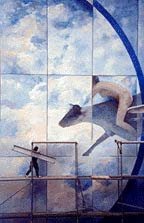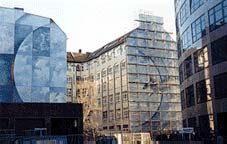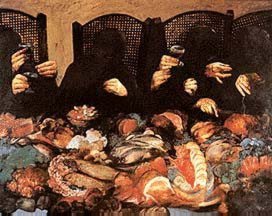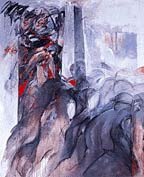
Spring 1995 (3.1)
Akbar
Behkalam
The Making
of Berlin's "Flying Cow"
by Betty Blair & Pirouz
Khanlou

See Akbar Behkalam's works
in AZgallery.org
It was a question of what architects
call "negative space". What can you do with that uninviting
space left over between buildings which somehow doesn't relate
to anything and which doesn't appeal aesthetically because of
darkness, disproportionate scale, or being sandwiched between
massive forms.
Not so long ago, a Berlin developer-investor approached Tabrizi-born
Azerbaijani artist, Akbar Behkalam (pronounced BEH-ka-lam) who
has been living in Germany for the past 25 years, wondering if
the artist could solve such a problem for him at a new shopping
center.

 Akbar Behkalam,
Azerbaijani Artist and Muralist from Tabriz living and working
in Berlin. Photo: 1995 in Los Angeles.
Akbar Behkalam,
Azerbaijani Artist and Muralist from Tabriz living and working
in Berlin. Photo: 1995 in Los Angeles.
When Behkalam first saw the
construction site, he envisioned "clouds, clouds, clouds".
He felt a great need to open up the claustrophobic spaces to
the sky. But what could he add to those clouds that would capture
the imagination of passersby? A bird? Maybe a human? Maybe an
Icarus-type figure flying towards the sun?
When he realized the location used to belong to a dairy, he hit
upon the idea, "Why not a flying cow?" In ancient mythology,
he recalled studying how the cow symbolized power and life. Central
to Behkalam's works is human interaction, therefore, it was only
natural that he would add a person in the mural. A naked woman?
Somehow it evoked images from Greek mythology of a fearless,
mysterious Amazonian riding bareback. Besides, he found it much
more intriguing to paint than a male figure.
A Ton of Paint
By early summer 1994,
he was ready to climb the scaffolding and begin the gargantuan
task of painting the 1,050 square meters of wall space. It would
take nearly a ton of paint before the job was done. Behkalam
lost 10 kilos of weight just swinging that 12-inch wide brush
and climbing up and down the scaffolding. It was so difficult
close range to understand what he was painting that he often
had to go down and view the mural from 200 meter's distance just
to get a sense of the contextual whole.
Actually, the concept for the mural is much like a mosaic, created
by the illusion of panels, each 2.5 x 5 meters or the equivalent
height of a two-storied building. Each panel can actually stand
alone as an independent painting.

 Akbar
Behkalam's "Flying Cow of Berlin" in the context of
the newly built shopping center built on the site of a former
dairy. The project took nearly one ton of paint and was completed
late 1994.
Akbar
Behkalam's "Flying Cow of Berlin" in the context of
the newly built shopping center built on the site of a former
dairy. The project took nearly one ton of paint and was completed
late 1994.
The finished mural has an extraordinary feeling of transparency
and fluidity. Sometimes on a clear day, people tell him that
it blends so well with the sky that it's hard to distinguish
that it's really a painting on a solid wall. It appears more
as a reflection of sky in a curtain glass walling.
Construction Workers
As Best CriticsUnlike
the isolation that artists often experience when painting alone
in their studios, an outdoor mural attracts critics at every
stage. With several hundred construction laborers on site, Behkalam
was showered with advice. But a rapport soon developed and the
workers dramatically influenced the final design. At first, they
didn't pay too much attention: A cloud? So what! But when Behkalam
began painting the cow and the woman, it started capturing their
imaginations. They would ask, "Why does the cow have only
one leg?" And Behkalam would joke, "A painter who can
draw one leg obviously can draw three just as easily, can't he?"
But in Behkalam's mind a flying cow didn't need additional legs.
Besides, four would have made it such an ordinary-looking creature!

 Behkalam's first
impressions of the Germans when he arrived there: obsessed with
eating. 1979.
Behkalam's first
impressions of the Germans when he arrived there: obsessed with
eating. 1979.
Behkalam has a tendency not to concentrate on individual personalities
of the people he paints.
Facial features are generally vague and non-identifiable. Maybe
that's why he didn't paint a head on the lady at first. But the
workers weren't happy and so Behkalam complied and the lady soon
had her head. The readjustment and positioning added 15 days
to the project. He finally finished the same day the scaffolding
was scheduled to be dismantled by the contractor-in November
1994.
This is the fifth time since the late 1970s that the foreign-born
artist has taken his brush to Berlin walls. Though he usually
paints inside his studio in East Berlin now that "the Wall"
has come down, it's possible that this mural will give him considerable
exposure, perhaps even more that the hundreds of works he's painted
before. "They're all part of me," Behkalam will admit,
"the wall murals, the museum pieces, and the works starting
to make their way into private collection." And upon close
analysis, there is a distinctive style that unites them all.
Challenge of a New
Audience
An artist's success
depends upon his ability to interact with his audience. "Now
that I live in Germany, I have a different audience to reach.
When you leave your own land, you start to think about it more,
you begin wondering 'Who am I?' 'What is this language I speak?'
'What is my past?' Sitting in Germany, I began searching for
my roots. I realized I could never really be a 'Peter', 'Hans'
or 'Jan', I could only imitate them. But when you know who you
are, then you can work to make your art understood and accepted."
Apart from themes, he also brings some technique and style from
his past. For example, the concept of miniature so common in
paintings back home greatly influences his work. He's fascinated
how a single frame can tell a complex story in itself and how
the figures are not drawn to perspective; those in the upper
part of the painting are understood to be further away even if
they are larger. The frame is often an integral part of the painting.

 "Moloch"
(Mixed media on paper, 240 x 200) by Akbar Behkalam. "This
is our urban scene today-the combination of both good and evil."
"Moloch"
(Mixed media on paper, 240 x 200) by Akbar Behkalam. "This
is our urban scene today-the combination of both good and evil."
Over the years, Behkalam has developed a distinctly recognizable
style. He's fascinated with the ideas of motion, change, violence
and suppression. Nor has he shied away from difficult themes.
Typically, he does a lot of research before picking up his brush.
He painted the "German Revolution of 1848" at a time
when he was living through the emotional impact of the Iranian
Revolution of 1979. His "Persepolis" series juxtaposes
tragic scenes of repressive modern life upon the images of the
glorious past. Recently, he has painted a series called, "Justice
in the name of God." Behkalam doesn't claim to be a political
painter but rather a mirror from which the reflection of some
of the gross injustices of modern social experience.
Behkalam tends to pick a theme and explore it with numerous paintings.
Like a mosaic, all the individual pieces together speak to the
complexity of the idea. But after about 25-30 paintings on a
given subject, he finds himself reaching a saturation point and
repeating himself. That's when he pulls back and starts exploring
another topic. "It makes me more creative to have to think
about new concepts. It arouses my curiosity when I discover relationships
and connections I've never seen before."

 Turks
in Germany: "We Don't Want To Become the Jews of Tomorrow"
(160 x 140, 1982) Commissioned to address fascism. Note historic
newspaper clipping in background showing branded Jews. Each man
in foreground protrays a portion of the original newspaper photo
and a Turkish man.
Turks
in Germany: "We Don't Want To Become the Jews of Tomorrow"
(160 x 140, 1982) Commissioned to address fascism. Note historic
newspaper clipping in background showing branded Jews. Each man
in foreground protrays a portion of the original newspaper photo
and a Turkish man.
Behkalam believes that every painter passes through certain phases,
artistically as well as thematically. Take color, for example.
His earlier works incorporate many shades of brown. Then he experimented
with gray, blue-gray, rust-brown and later yellow and some black
and red. Conspicuously absent from his work are shades of green.
He'll tell you it's because he grew up in Tabriz (Iranian Azerbaijan),
where the winters were harsh; summers, hot; and landscape, rocky.
So his eyes got used to the colors of earth and sky. He's the
first to admit that his palette is quite different from most
German artists'.
Finding Universals
Beyond Nationality
Behkalam has been living in
Germany for 25 years now, but he still feels like a foreigner.
"Twenty-five years from now, I'm sure I'll still feel the
same. I have a German passport but I'm still a foreigner to everybody
here." But Behkalam doesn't linger on the issue of whether
he's Azerbaijani, Iranian or German. "I'm me," he'll
tell you. "I bring a certain history to my work that gives
me a specific perspective. I can't change that. I can't change
what is inherent in me. Over time, I've tried to adapt to my
environment; to 'soften' the differences between me and my German
wife and our children. But, basically, I haven't really changed."
It's not the only thing he brings from his past. Actually, the
very fact that he's Azerbaijani seems to have played a significant
role in his becoming an artist. Behkalam traces the decision
back to his youth and the process of foreign language learning.
Born in 1944 in Tabriz, Iran's second largest city which is Azeri,
from the first day of school onwards, he was required to learn
to read and write in the official national language, Persian,
and not his mother tongue, Azerbaijani. Behkalam admits to the
difficulties that followed. To this day, he doesn't feel completely
comfortable with Persian. "Early on, I began to realize
it was easier for me to express myself in colors and lines than
in a foreign language. From that time onward, I wanted to become
a painter."
What's next? Not long ago the German Social Democrats in Berlin
invited seven artists to compete for a sculpture they wanted
to erect. Behkalam the only painter and six other sculptors were
asked to come up with a design that would commemorate the tragic
situation that occurred when the German court ordered a foreign
immigrant expelled from their country. Choosing death over expulsion,
the alien threw himself from his apartment to the sidewalk below.
Behkalam proposed to carve negative space out of granite, creating
the same effect that footprints make in snow and symbolizing
the great loss of a life that somehow is reflected in the very
common Azerbaijani expression, "Your placing is missing."
Behkalam won the competition. Sculpturing is a new genre for
him. If he succeeds, as he always has in the past, it will be
one more landmark in the city of Berlin created by the touch
of his genius.
For more information about his works, refer to Akbar Behkalam:
Movement and Change: Paintings and Sketches 1977-1988. (112 pages).
Published in 1989 by Mazda Publishers, PO Box 2603, Costa Mesa
CA 92626, USA.
Akbar Behkalam: Bewegung und Veränderung, Bilder und Zeichnungen,
1976-1986. Nicolaische Verlagsbuchhandlungm: Berlin, 1987 (264
pages).
Home | About
Azeri | Learn
Azeri | Arabic
Script | Store | Contact
us
Articles from Azerbaijan
International
© Azerbaijan International. Copyright 2002. All rights reserved.
|
|